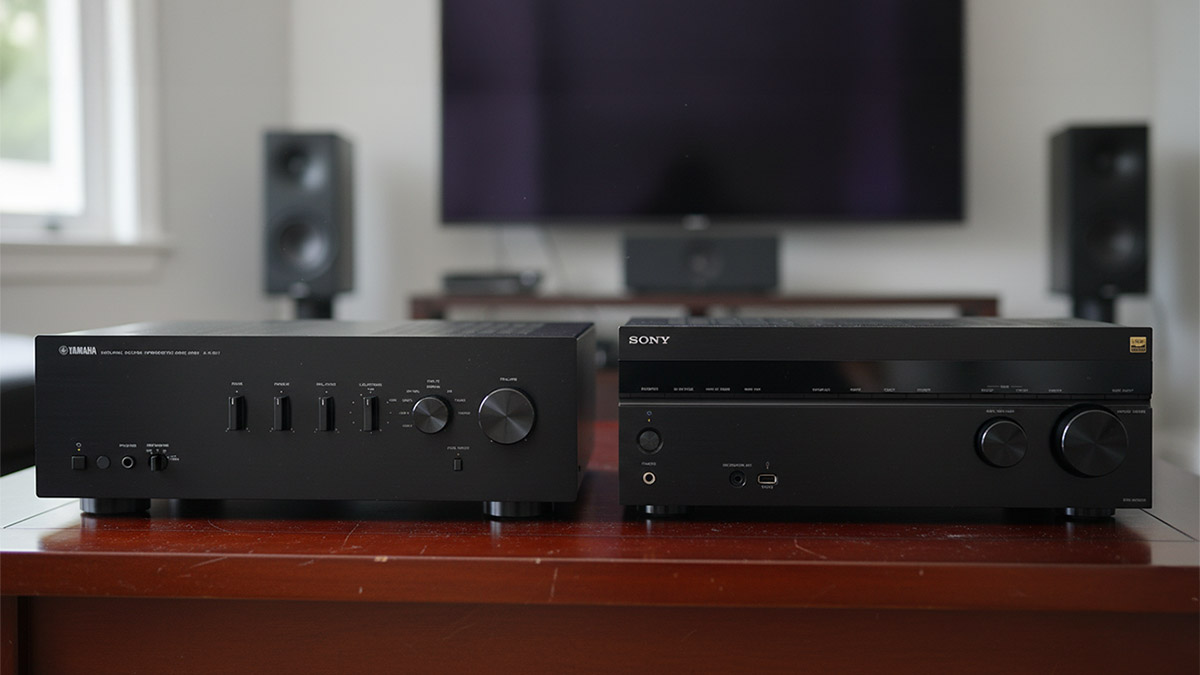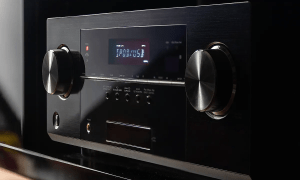You have speakers ready and a stack of sources, now you need the engine that makes everything sing. Two choices dominate this space, the AV receiver and the stereo amplifier. Both deliver power, both can sound excellent, yet they are built for different jobs. Once you see what each one actually does in a real room, the decision gets easy.
What each one is, in plain language
A stereo amplifier focuses on left and right. It takes a small line level signal, raises it cleanly, and hands stable current to two speakers. Many integrated amplifiers add input switching, volume control, a phono stage for a moving magnet turntable, and sometimes a simple digital input. Think Yamaha A S301, Cambridge Audio AXA35, Denon PMA 600NE, Marantz PM6007. Fewer features, more attention on the power supply and output stage.

An AV receiver is a control hub plus a multi channel power amp in one box. It accepts HDMI from consoles and streamers, routes video to the TV, decodes surround formats, manages bass, runs room correction, and powers five to nine speaker channels in most living rooms. Current examples include Denon AVR S670H, Yamaha RX V6A, Onkyo TX NR6100, and Sony STR AN1000.
How design shapes what you hear
Stereo amps keep the path short. With fewer processing stages and fewer menus, it is easy to achieve a quiet background and a stable center image from two speakers. AV receivers juggle more tasks. They can sound superb, but they reward good setup. Keep processing honest, disable post effects you do not need, set sensible crossovers, and let bass management do the heavy lift below.

Why it matters, signal path
Every extra conversion or filter can add a little noise or latency. A clean two channel path is simple by nature. A clean multi channel path is possible, it just needs intention, direct or pure modes for music, cinema modes for movies, no unnecessary post processing.
Where the money goes
In a stereo amplifier, most of your dollars buy power supply, output devices, and a quiet pre section. In an AV receiver, the budget spreads across many channels, the digital board, video switching, streaming features, and the room correction system. That is why a good stereo amp at the same price can feel more effortless with music. You are paying for two strong channels rather than seven lighter ones.
Why it matters, real headroom
Real music and film have a crest factor around 10 to 20 dB. Peaks jump far above the average level. The gear that holds those peaks without strain feels calm and clear. A modest amp with stout reserves can sound more relaxed than a bigger unit with a weak power supply.
Power numbers that actually mean something
Spec sheets love big watt claims. Read them with context. Look for continuous power into 8 ohms and into 4 ohms, both channels driven, across 20 Hz to 20 kHz. That set of numbers tells you the supply has muscle. With AV receivers, note that many headline ratings are taken with one channel at a time. Real scenes light several channels at once, so per channel headroom drops.
Why it matters, all channels driven
As a quick rule of thumb, expect about half to two thirds of the one channel rating when five or more channels are working hard. Plan your system around that reality and you will not be surprised on big action scenes.
Room correction, friend and tool
Stereo amplifiers usually skip room correction. You set placement by hand, maybe add small acoustic panels, and enjoy a very direct path. AV receivers bring measurement microphones and smart math. They time align speakers, set levels, and can smooth bass modes that plague most rooms.
Why it matters, target curve
The measurement is science, the target is taste. A gentle downward tilt from bass to treble suits many living rooms. Correct bass strongly below 300 Hz, ease up above that so vocals keep life. If the top end feels lean after correction, try limiting correction to bass, then use a tiny tone lift on treble.
Bass management changes the game
Stereo amplifiers usually feed full range to the speakers. If your speakers are compact, deep bass can blur the midrange. Some subs offer high pass outputs that filter bass out of the mains. That one feature tightens imaging and protects small woofers.
AV receivers handle this elegantly. Set the mains to small, choose an 80 or 90 hertz crossover, and the receiver sends bass to the sub while relieving the mains. Dialogue clears, dynamics relax, and the system sounds bigger without getting louder.
Why it matters, clarity not just bass
Crossing mains to a sub reduces cone travel through the vocal range. Less excursion means lower distortion. That is why a well set receiver with a good sub can beat a full range stereo setup that asks small speakers to dig deep.
RELATED: AV Receiver vs. Stereo Amp. Which is Better for Music
Connectivity and control
Stereo amplifiers keep it focused. Expect a couple of analog inputs, maybe coax or optical, perhaps Bluetooth, and often a moving magnet phono input. The goal is quiet, clean, simple.
AV receivers are the living room hub. You get multiple HDMI inputs, one cable audio return from the TV through ARC or the newer enhanced version, streaming services, app control, and often voice assistant hooks. If you want one remote to rule the room, a receiver keeps the family happy.
Why it matters, ARC versus eARC
ARC carries compressed surround and stereo, eARC carries uncompressed multichannel and is less fussy about lip sync. If you use TV apps for most streaming, eARC support on the receiver is worth seeking out.
Upgrade paths that keep options open
Music first listeners can choose an integrated amplifier with home theater bypass. You run pure two channel for music, then feed the power section from a receiver for movies later. Movie first listeners can start with a receiver that includes pre outs. Add a dedicated stereo power amp for the fronts down the road while the receiver powers the rest.
Why it matters, pre out strength
If you plan to add an external amplifier later, check that the receiver offers solid pre out voltage and a quiet background. A strong pre stage avoids bottlenecks when you upgrade.
When to pick a stereo amp without hesitation
Choose a stereo amplifier if music is the priority, your setup is two speakers and a sub, and you value a short signal path. Small to medium rooms and moderately sensitive speakers make this path shine. Cambridge Audio AXA35 with ELAC Debut 2.0 B6.2 is a simple, satisfying pair for a tight budget. Yamaha A S301 with KEF Q350 brings more grip and a built in phono stage for vinyl. Add a sub with high pass outputs and you have a tidy system that punches above its price.
Why it matters, level matching
When you compare, match playback levels within 0.5 dB using pink noise and a simple phone meter. Louder almost always seems better. Matching levels lets you judge tone and imaging fairly.
When an AV receiver is the easy win
Pick an AV receiver if you watch a lot of movies, want clear dialogue, and plan to add surrounds or height channels. Denon AVR S670H handles 5.2 and streaming. Yamaha RX V6A brings friendly control and flexible processing. Onkyo TX NR6100 covers gaming and theater with responsive handling. Start with 2.1, add a center for stronger dialogue, then build toward 5.1 when space and budget allow.
Why it matters, latency and cooling
Receivers add processing time. Use game modes and keep extra post effects off if you are sensitive to lag. Give the chassis breathing room. Some compact designs use small fans under load, so ventilation space keeps things quiet and reliable.
Real power for real speakers
Speakers are not flat loads. A nominal 8 ohm box can dip near 4 ohms in the bass with a steep phase angle. That is a tougher ask than the printed number suggests. If your speakers are known for a challenging load, favor gear that publishes honest 4 ohm performance across the full band.
Why it matters, protection behavior
Two products with the same power can behave differently at the edge. Look for gear that mutes cleanly rather than crackles or hard clips when pushed. That is kinder to tweeters and ears.
Model paths that just work
Two channel path:
Yamaha A S301 with ELAC Debut 2.0 B6.2, add a sub that offers high pass outputs for a cleaner midrange.
Living room theater path:
Denon AVR S670H with Polk ES15 fronts and an 8 to 10 inch sub, start with 2.1 and grow.
Flexible do everything path:
Onkyo TX NR6100 with KEF Q350, later add a KEF center and surrounds when ready.
Practical checklist before you buy
Measure seating distance and typical volume. If you sit 8 to 10 feet from the speakers and listen at moderate levels, a clean 60 to 80 watt stereo amp or a capable midrange receiver will be plenty with average sensitivity speakers. If you chase concert levels or your speakers dip low in impedance, favor units that publish strong 4 ohm numbers. Make sure features match habits. Vinyl fan, look for a decent phono input. TV first listener who wants one cable for sound, look for ARC or eARC.
Bottom line
A stereo amplifier is a focused tool for two channel listening. Fewer features, more attention on clean power, and a short path make it a joy for music. An AV receiver is the hub for everything you watch and play. It brings decoding, bass management, and room correction that tame real rooms and keep daily use simple. Decide by use case, not folklore. If you live in two channel and want the most direct route to great sound, pick the amplifier. If you want movies, gaming, and easy switching with room friendly bass, pick the receiver. Match honest power to your speakers, lean on good placement, use bass management with intent, and the difference you hear will be music rather than guesswork.
Teksignal.com participates in the Amazon Services LLC Associates Program, an affiliate advertising program designed to provide a means for sites to earn advertising fees by advertising and linking to Amazon.com. The reviews on this site are hands-off consensus reviews. We analyzed owner feedback across the internet and manufacturer documentation. We summarize sentiment; we do not republish individual user posts.



























